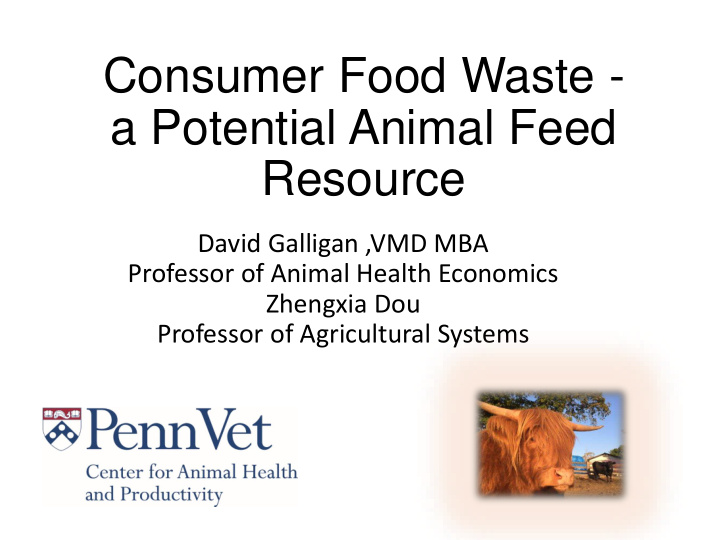



Consumer Food Waste - a Potential Animal Feed Resource David Galligan ,VMD MBA Professor of Animal Health Economics Zhengxia Dou Professor of Agricultural Systems
Animal Agriculture • “providing our dinner” or “taking our lunch” ? • Competes for use of resources (land, water, .. .) for other activities. Our Focus: • What is the “appropriate role” of animal agriculture in a sustainable system? • Can they play a synergistic role?
Historical approach to improving animal efficiency • Increase yield/animal unit Mechanism • Dilution of animal maintenance cost • More yield/animal, requires fewer animals, fewer replacement animals and fewer resources proportional to animal numbers. Link to Milk Intensity PDF
New dim imensions of f efficiency – use of human food waste as animal l feed • 30% of Human Food Production is used as by products in animal feeding systems • However Food Waste in U.S. is very large
The Magnitude of f the Problem FLW along the food chain Processing Consumption On Farm Manufacturing Stage 9.1 Mt 0.9 Mt 47 Mt
The Magnitude of f the Problem Retail and consumer food loss by food group Dairy products 64% 11.5 36% 11.4 28% Vegetables 72% 39% 61% Grain products 8.4 8.4 32% 68% Fruit 27% 73% 7.6 Added sugars… Meat, poultry,… 18% 82% 7.0 Retail loss 45% 4.5 Added fats and… 55% Consumer loss\1 1.3 Eggs 25% 75% Tree nuts and… 0.2 36%, 64% 0 2 4 6 8 10 12 Million metric tonnes
Resources and Fin inancial Drains wit ith Retail and Consumer Le Level FLW • 27% of cropland • 25% of irrigation water • 26% of fertilizer • 25% of energy • Retail value of $161.6 billion • Intangible impacts, e.g. water pollution, GHGs, biodiversity, and habitat loss
FLW Reduction, , Recovery ry, and Recycling U.S. 2030 FLW Reduction Goal: 50% Seattle, New York City San Francisco Boulder Austin States with food waste regulations Cities with food waste regulations
FLW Reduction, , Recovery ry, and Recycling The Hierarchy Source reduction Reduction/ Prevention Food rescue for people Feeding animals Recovery/ Diversion Industrial uses Composting Incineration Recycling AD Landfill Disposal
Majo jor Data on Food Waste Prevention and Recycling Hierarchy Mt Notes Prevention 0.32 Manufacturer donation (rescue/donation) to feed 0.30 Retail/wholesale donation people 0.008 Farm gleaning 1-2 Mt 0.19 Donation, Feeding America data 0.56 Donation from consumer and retail Diversion 13.9 Manufacturer diversion to feed nonhuman beneficial use animals 0.1 Retail/wholesale diversion to feed animals 15 Mt 1.1 Restaurant grease recovery Recycling 5.0 Manufacturer-reported composting 0.53 Retail/wholesale reported composting 7-8 Mt 1.42 EPA data on composting 1.66 Survey response of 24 states
Interpretive Analysis In Ch Changing food-wasting behavior • No one buys food to throw it away but... • Our decisions and actions are not necessarily rational or straightforward… • Nudging for behavioral change… Maintenance Action Preparation Contemplation Precontemplation
In Interpretive Analysis Technolo logies and th the 50% reduction goal • Composting • Reduced volume, moisture, and pathogens • Compost as soil amendment • Anaerobic digestion (AD) • Biogas as a source of renewable energy • Digestate as soil amendment • Efficacy, costs-benefits, scale-up? • Tradeoffs?
In Interpretive Analysis A game ch changer? Energy Water Processing Consumption Agricultural Fertilizer manufacturing crops stage Land 47 Mt 1 Mt Soil erosion 9 Mt N&P losses Livestock GHGs animals Biodiversity Grain spared Save resource ReFeed Reduce pollution
Conclusions • Sustainable food consumption must be taken into account of the food security and sustainability agenda. • Food waste prevention is a top priority; changing consumer wasteful behavior is essential. Still, need all workable solutions. • Technologies have a critical role to play. Research must evaluate the overall impacts of different technologies on food, energy, water, other resources, economic viability, and environmental-climate outcomes.
Questio ions/Discussion Zhengxia Dou douzheng@vet.upenn.edu This CAST Issue Paper is available at www.cast-science.org/ publications .
Recommend
More recommend